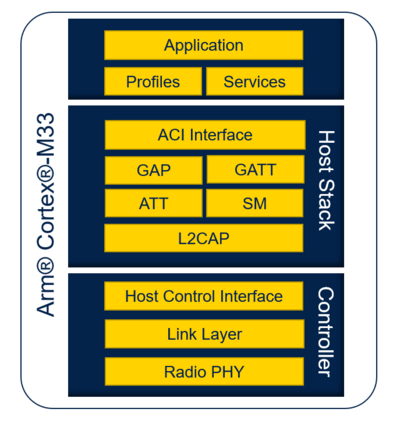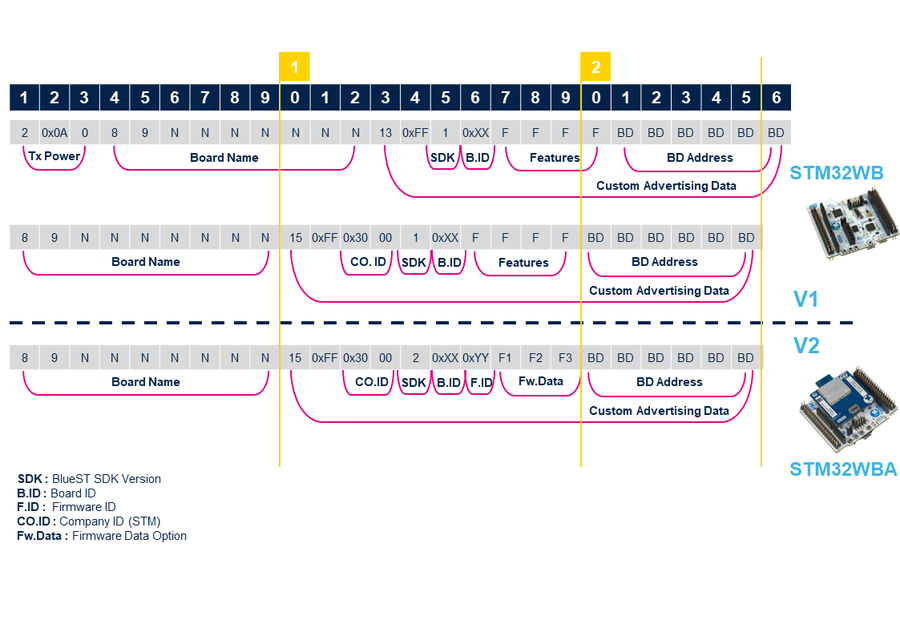Click here for Bluetooth® Low Energy Overview
1. Introduction
The STM32CubeWBA MCU Package[1] provides software components running on STM32WBA series MCUs.
For all examples provided within the package, the following integrated development environments are supported:
- STMicroelectronics integrated development environment for STM32 products (STM32CubeIDE)
- IAR Systems® IAR Embedded Workbench® for Arm® (EWARM)
- Keil® Microcontroller Development Kit (MDK-ARM)
The Firmware Package for the STM32WBA series is also available on STM32CubeWBA github[2].
2. STM32WBA Bluetooth® LE software architecture
The single Core Arm® Cortex®-M33 STM32WBA Bluetooth® low energy solution is designed to develop application firmware including Profiles & Services on top of the Bluetooth® Low Energy Firmware Stack (Controller & Host) handling the link layer up to the generic attribute profile and generic access profile layers.
| STM32WBA Bluetooth® LE architecture |
|---|
3. STM32WBA Bluetooth® LE applications
The following Bluetooth® LE applications are delivered as source code
- To build and install them, follow the steps described in Bluetooth® LE Build and Install Application page
| Application | Description | |
|---|---|---|
| Bluetooth® LE SIG | BLE_Beacon | Application advertising different types of beacon: ibeacon, eddystone (tlm, uuid, url) |
| BLE_HealthThermometer | Application supporting the Health Thermometer Sensor as specified by the Bluetooth® SIG | |
| BLE_HeartRate | Application supporting the Heart Rate Sensor as specified by the Bluetooth® SIG. | |
| BLE_HID_Mouse | Application supporting the Human Interface Device as specified by the Bluetooth® SIG. | |
| Bluetooth® LE Audio | BLE_Audio_PBP | Public Broadcast Profile as specified by the Bluetooth® SIG |
| BLE_Audio_TMAP | Telephony and Media Audio Profile as specified by the Bluetooth® SIG | |
| BLE_Audio_HAP | Hearing Access Profile as specified by the Bluetooth® SIG | |
| BLE_Audio_GMAP | Gaming Audio Profile as specified by the Bluetooth® SIG | |
| Operating System | BLE_HeartRate_ThreadX | Application supporting the Heart Rate Sensor with ThreadX implementation |
| Bluetooth® LE ST proprietary | BLE_p2pServer & Multi Slave BLE_p2pClient | Simple ST proprietary applications to manipulate proprietary Services & Characteristics with single connection or multi slave connections |
| BLE_p2pRouter | ST proprietary application to use the STM32WBA as a GAP Central & Peripheral" and "GATT Client & Server with multi link connection | |
| BLE_DataThroughput | ST proprietary application to measure data throughput between 2 STM32WBA or with the dedicated ST Bluetooth® LE toolbox smartphone application (Android and IOS) | |
| BLE_Fuota (Firmware Update Over The Air) | ST proprietary application to update the STM32WBA firmware | |
| BLE_SerialCom | ST proprietary application to simulate the previous Bluetooth® protocol "Serial Port Profile". The application is based on L2CAP Connection Oriented Channel (CoC) | |
| BLE_p2pServer_Ext | Application to configure up to 8 advertising extended sets | |
| BLE_p2pClient_Ext | Application to scan the extended advertising frames with extended API’s | |
| BLE_p2pServer_TZ | Application similar to BLE_p2pServer with the TrustZone being activated and the Blue LED being connected to the Secure side of the MCU. | |
| BLE_Power_Peripheral & BLE_Power_Central | Simple ST proprietary applications to measure low power system consumption with different configurations (Advertising, Connected, Packets transfer) | |
| BLE_TransparentMode | ST proprietary application to support the Direct Test Mode for RF certification. Standard host controller interface (HCI) and application (vendor) controller interface (ACI) can be sent by means of STM32CubeMonitor-RF |
4. Manufacturer Advertising Data & BlueST SDK v2
4.1. Background and motivations
BlueST SDK v1 development started in 2015 and has grown over time with the addition of more and more functionalities that enable microcontroller firmware to advertise its capabilities and exchange data with mobile applications as well as industrial gateways via Bluetooth® Low Energy.
BlueST SDK[3] is shared as opensource code on multiple github repositories for Android, iOS and Python.
The STMicroelectronics vendor-specific advertisement allows declaring characteristics that are implemented by the device. A 4 bytes feature mask is a bitfield where each bit represents a feature, e.g. accelerometer, temperature, freefall, compass etc. In the vendor-specific advertisement, 1 byte is used to indicate the evaluation board model.
As firmware packages and board models grow in number and supported functionalities, a new mechanism is needed to overcome the 4 bytes feature mask limitations.
The main purpose of the BlueST SDK v2 protocol is to allow a client to recognize the board type and the firmware capabilities of the board in proximity and to be future proof.
The mapping between Board ID / Firmware ID and the actual description of the firmware capabilities relies on a JSON document[4].
| BlueST SDK v1 vs BlueST SDK v2 |
|---|
4.2. BlueST SDK v2 & STM32WBA Bluetooth® LE Applications
As described below, some of the STM32WBA Bluetooth® LE Applications use the BlueST SDK v2 protocol
| BlueST SDK v2 protocol & STM32WBA Bluetooth® LE Applications | ||||||||||||||||||||||||||||||||||||||||||
|---|---|---|---|---|---|---|---|---|---|---|---|---|---|---|---|---|---|---|---|---|---|---|---|---|---|---|---|---|---|---|---|---|---|---|---|---|---|---|---|---|---|---|
|
4.3. Device Information Characteristic
The BLE applications of the STM32Cube MCU Package for STM32WBA series, embed a proprietary characteristic that provides the following information linked to your device:
| Byte | 0 | 1 | 2 | 3 | 4 | 5 | 6 | 7 | 8 | 9 | 10 | 11 | 12 | 13 | ||||||||||||||||||||||||||
|---|---|---|---|---|---|---|---|---|---|---|---|---|---|---|---|---|---|---|---|---|---|---|---|---|---|---|---|---|---|---|---|---|---|---|---|---|---|---|---|---|
| Field | Device ID | Rev ID (cut x.x) | Board ID | HW package | FW Version | App FW ID | Host Stack Version | Host Stack Type | ||||||||||||||||||||||||||||||||
| Details |
|
| ||||||||||||||||||||||||||||||||||||||
The Android ST BLE Toolbox application and our Web Bluetooth interface can be used to display this information.
| ST Web Bluetooth Application Interface - Device Information Characteristic - Nucleo WBA65RI Example |
|---|
5. References


